Finding Joe Smith
Writer Alison Morse sets out to unpack Joe Smith's beguiling, mysterious objects to get a sense for the elusive artist himself, whose work is on view in the Soap Factory's biannual survey of Minnesota artists, "A Theory of Values," through October 24.
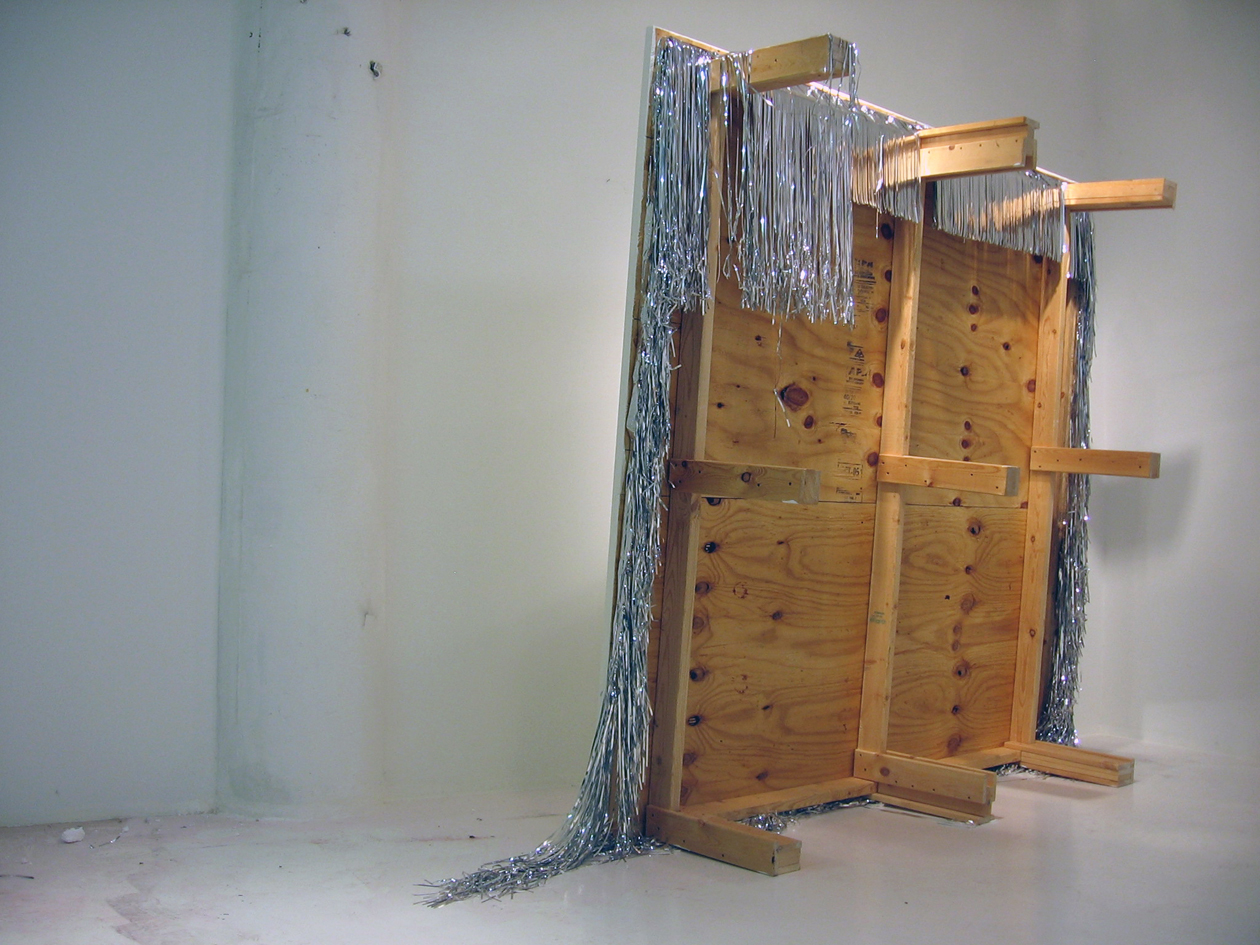
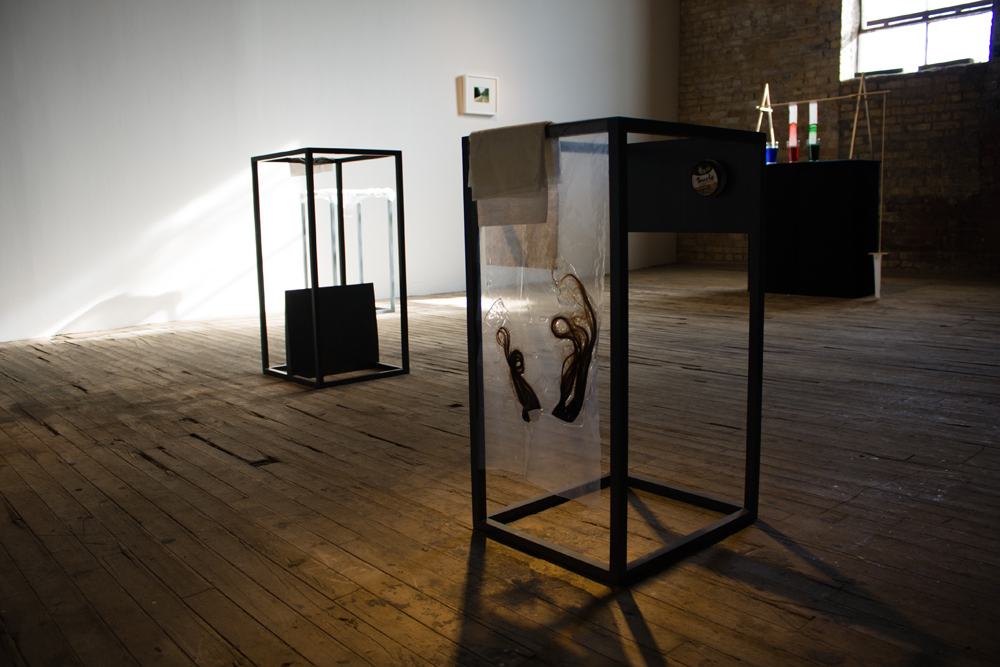
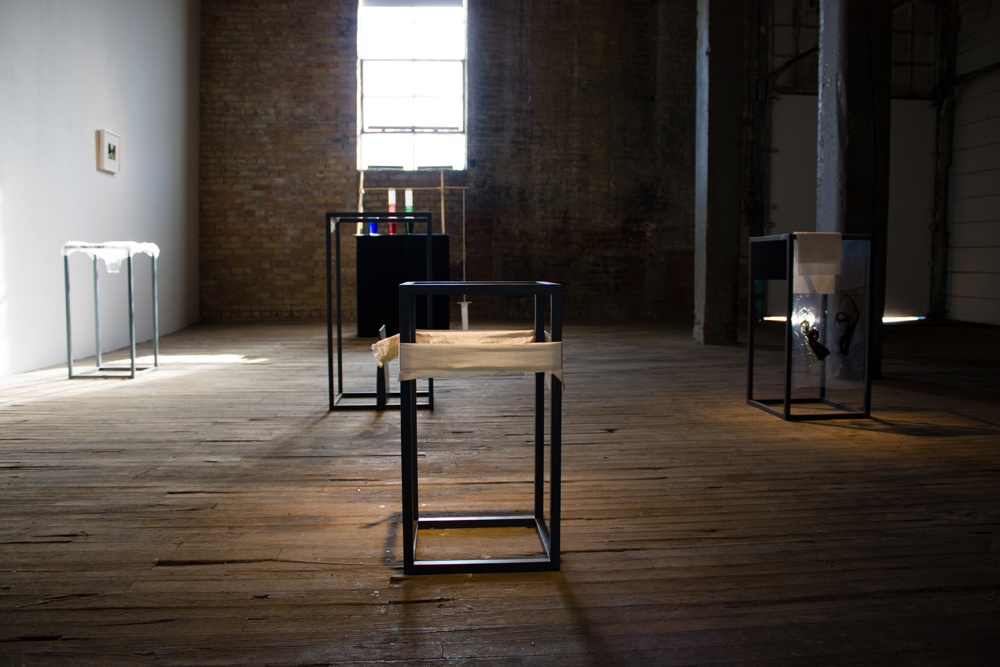
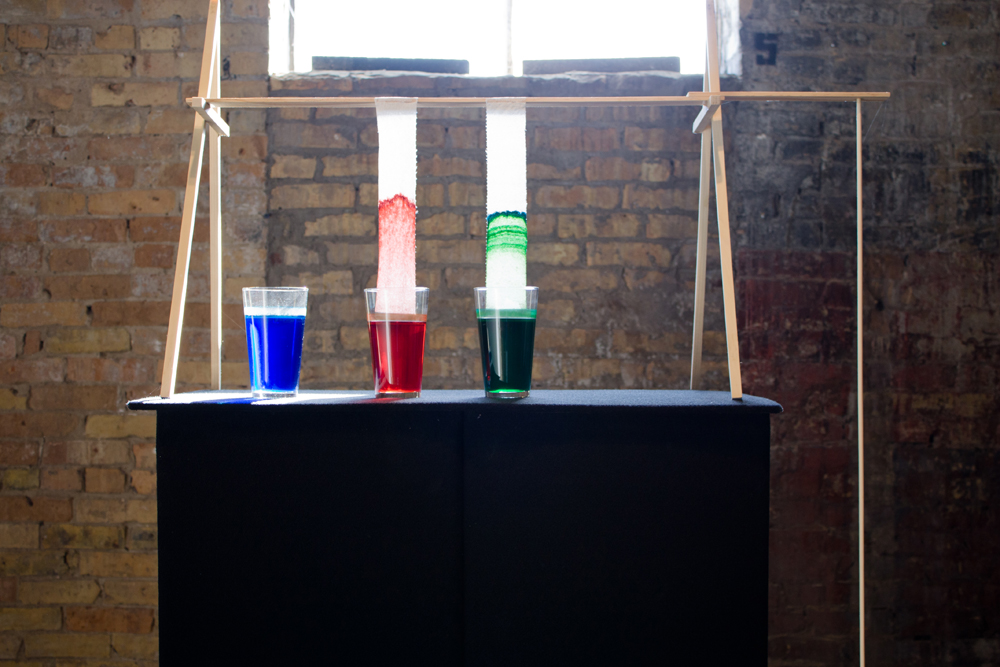
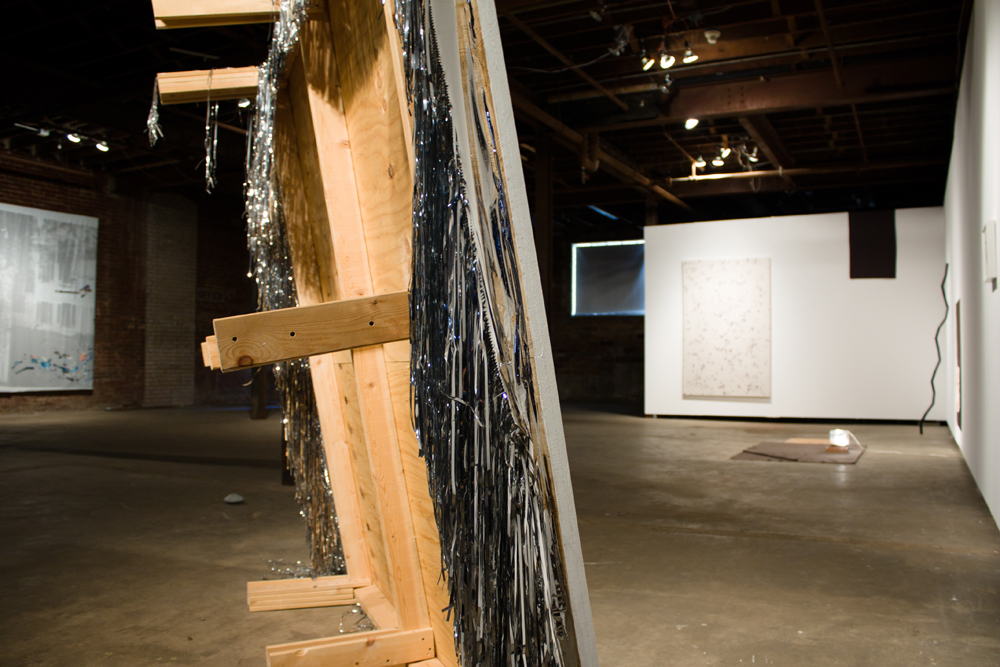
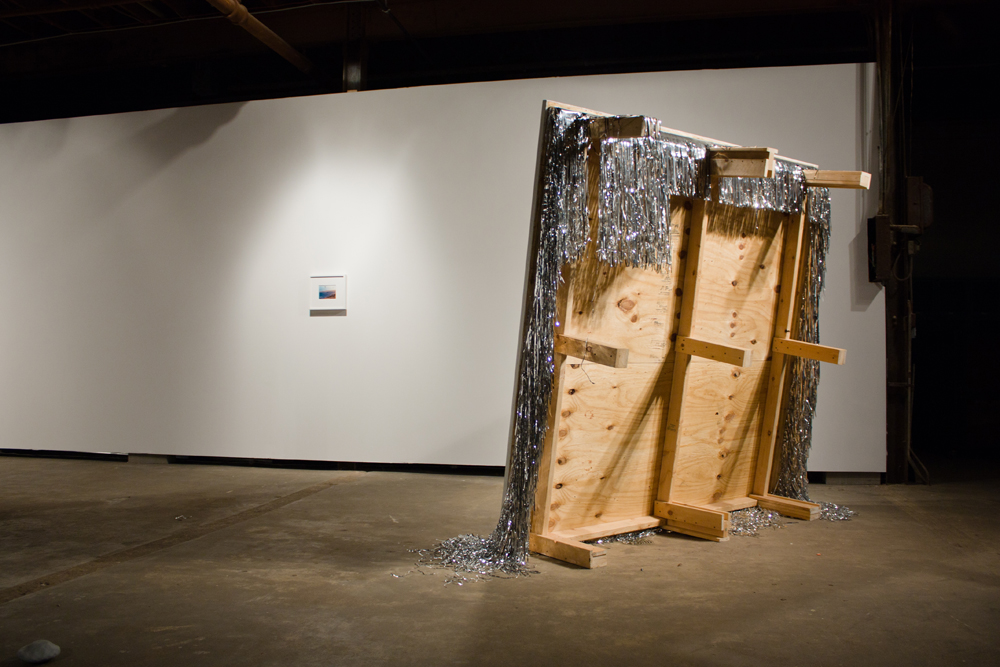
I GO TO THE OPENING OF THE SOAP FACTORY gallery’s Minnesota biennial show, A Theory of Values, curated by Kris Douglas and Scott Stulen, to see what a slice of my region’s artists have been up to. The first work of art I encounter is the bottom of an upended wooden platform, its legs facing me, its sides fringed in silvery Mylar — the kind of cheesy decoration I associate with a bar stage. The top end of the platform faces the wall, reflecting light from its Mylar-covered surface. What is this object? Evidence of a garage-band performance gone awry? All the elements of a painting (light and shadow, pattern, rectangular frame, edges, and activated surface), but without a single drop of paint?
I laugh out loud. The piece is by an artist new to me: Joe Smith.
A couple of rooms away, I find another, entirely different sort of sculpture by the same artist: a felt-covered table holding three glasses of colored water. Over the table, dangling from a flimsy wooden contraption, are two strips of paper towel; one hangs into a glass of red water, and the other into a glass of green water. A third paper towel, attached to a dowel, hangs just next to the table, falling almost to the floor.
I laugh again, wondering why this Rube Goldberg cleaning machine looks so familiar. It’s time to ask the artist himself. I am directed to Joe Smith, a tall, bald, imposing man with black glasses and a resonant voice. He tells me that the table with the colored water glasses looks familiar, because it’s a recreation of his wife’s fourth grade science experiment, which was itself a reenactment of a TV ad for Viva paper towels (“In a test of strength and absorbency, Viva wins!”).
Smith also calls my attention to other objects in the room, four cubic frames, each of whose pristine minimalism is marred by the addition of everyday objects like wet paper towels, a bag of hair clippings, the silky edge of a baby’s blanket, a container of air freshener. He says he made these objects in response to the question, “How do you cover over something, wipe away its residue?” That is, “If I say something wrong, I have to cover over it, because I can’t take it back.”
The concept behind the work is striking: as simple as interpersonal relationships but as far-reaching as the British Petroleum oil spill. In fact, the more I stare at Smith’s deceptively familiar objects, the more beautiful and mysterious they become. I feel like I’ve discovered something big.
While Joe Smith and his work may be new to me, it turns out he’s been around the Twin Cities for a while, showing at venues like the galleries at Midway and Chambers, and teaching in the art department at Northwestern College.
Art historian and critic Johanna Burton has written about Smith’s work, saying that it “invokes irreconcilable opposites in order to posit a space between.” The artist, himself, occupies a similarly ambiguous space. He is well respected by his peers, yet when I attempt to look him up online after seeing the exhibition, I’m able to find almost no information. “It’s nice to stay below the radar,” he shrugs.
He may keep a low profile, but he’s not unrecognized; he received a prestigious McKnight artist grant in 2004. Smith considers himself a “regional artist who knows what it means to be Minnesotan,” yet he defines his art practice as “going outside Minnesota and bringing it back” — “it” being the ideas and practices of internationally recognized artists outside Minnesota.
“I’m in between things partly because I’m adopted, and the product of divorced parents,” says Joe. “But I’m not searching for an identity.”
As a teenager, he says, he fell in love with painting; it was not part of his high school’s curriculum, so he worked on his own, pursuing independent studies of the form that continued through his graduate years at Cranbrook Academy of Art. In his first year at Cranbrook, he made up for the holes in his art history background by camping out in the library. He remembers, “I looked and looked and let it wash over me.”
Joe started with the contemporary artists he admired, like Richard Tuttle and Haim Steinbach, then he followed their influences back through time. In graduate school and beyond, Smith began experimenting with painting’s formal possibilities: Could a painting be flat, dimensional, and sculptural? Could it be something other than an object?
He was still exploring these questions when Phillipe Vergne, former Chief Curator at the Walker Art Center, now Director of Dia Art Foundation, came to Smith’s studio to talk with him about his work. Vergne responded most enthusiastically to the two pieces with the fewest formal ties to painting: a narrow slit in a wall that fit under a doorway — minus the door — and a dirty towel wrapped around a column with packing tape.
Vergne’s reaction challenged Smith to wonder if his focus on the formal elements of painting might be a crutch. If he took that away, what would be left?
________________________________________________________
Smith invites the viewer to slow down and look at the gestures implied by his objects, as well as the cultural associations we bring to his materials and constructions — then he asks us to look beyond both to something that he calls “presence.”
________________________________________________________
What’s left defies category or form — it’s a conundrum. Many of Joe Smith’s installations are three-dimensional, but they also incorporate drawings, photographs, white noise, liquids, smells. His work isn’t flashy, and it doesn’t declare itself — in fact, some viewers have mistakenly sat on it. He uses materials like packing tape and dirty towels that are cheap and easy to find, yet he is a meticulous craftsman who has been known to spend two weeks spackling and sanding a hunk of drywall so that it disappears into a gallery wall. Many of Smith’s objects are loaded with personal, if unexplained associations. At one of his shows, his wife Lesli exclaimed: “Our whole life is laid bare for all to see!” But to the uninitiated eye, those same pieces look almost random — an accumulation of untitled, inexplicably charged objects.
Actually, Smith doesn’t often title his work, explaining, “As soon as I put a title on something, then you don’t have to work so much. I spent a lot of effort. I ask you to do a little work, too.”
Smith is part of a long line of conceptual artists that make objects, three-dimensional works that are neither painting nor sculpture. Donald Judd, one of his famous forbearers, wrote about this kind of art in his 1965 essay, “Specific Objects” (PDF), where, according to Johanna Burton, “Judd argued for objects in ‘real space,’ hoping to sidestep illusionism and anthropomorphism.”
But Smith’s artwork resists Judd’s call for a self-contained art object. Instead, he presents a plethora of parts that somehow relate to each other and the world outside them, like evidence at a crime scene (in fact, two of Smith’s photos at the Soap Factory are shots of crime scenes downloaded from the internet). But Smith doesn’t say what the crime is; instead, he invites the viewer to slow down and look at the gestures implied by his objects, as well as the cultural associations we bring to his materials and constructions. Then he asks us to look beyond both, to something that Smith calls “presence.”
I have found myself drawn back to the Soap Factory more than once to look at Joe Smith’s work. I can attest to the fact that his objects and photos hold even more power on multiple viewings. In a way, both the artworks and their reticent maker strike me as quintessentially Minnesotan: industrious, yet humble; eloquent, yet resistant to definition; in conversation with the wider art world, but unbound by it.
________________________________________________________
Noted exhibition details:
A Theory of Values, the Soap Factory’s biannual survey show of Minnesota artists (curated this year by Kris Douglas and Scott Stulen), will be on view in the gallery through October 24.
________________________________________________________
About the author: Alison Morse is a writer, teacher, and former animator. She also runs TalkingImageConnection (TIC), an organization that brings together writers, contemporary visual art, and new audiences. Alison will participate in the mnLIT reading on October 18th at The Red Stag Supper Club. The next TIC reading will be on February 12, 8pm at the Soap Factory in response to Belongings, a site-specific video work by Rosemary Williams.
________________________________________________________
Work Cited:
Burton, Johanna. “MCAD/McKnight Essays.” MCAD/McKnight Artists 2004-2005 Catalog. Minneapolis: Minneapolis College of Art and Design, 2005. Print.